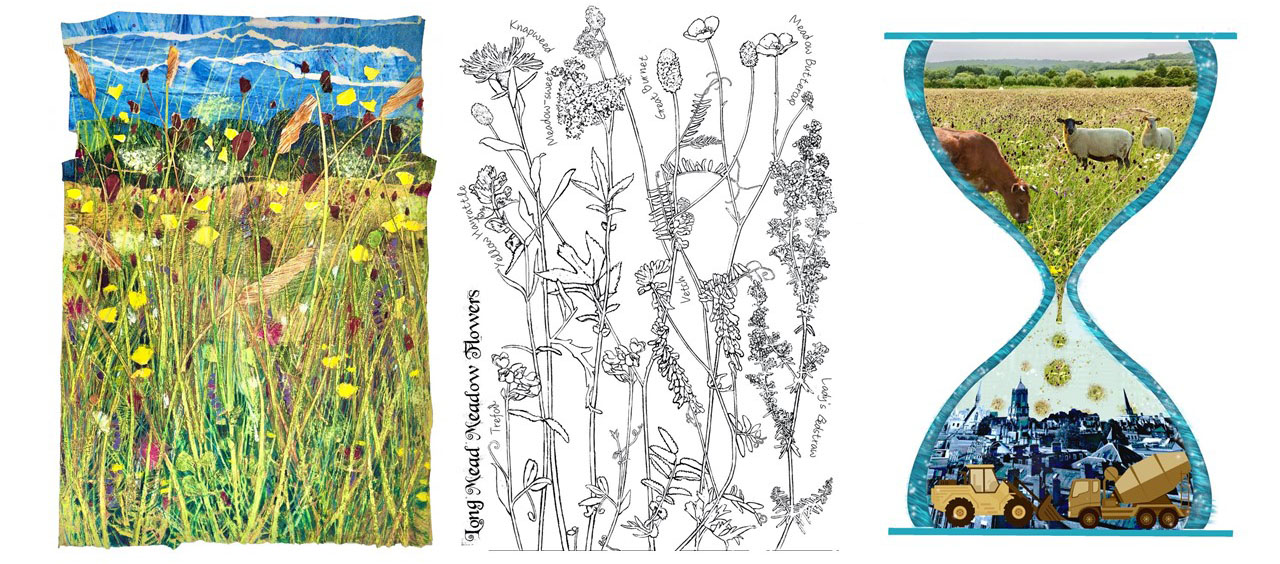Several 5-minute video interviews with farmers and other land managers were a brilliant way of bringing site visits on-line. It was so refreshing to hear their different voices! The videos can be seen here
https://www.youtube.com/watch?v=dZY4YQ0n14o
https://www.youtube.com/watch?v=VIQ8A-6U66E
https://www.youtube.com/watch?v=wdxkO0vlEa4
https://www.youtube.com/watch?v=Tc1ICCngsio
Day 2 explored the critical role of diverse floodplain grassland soils in securely storing significant quantities of carbon at depth/over time and the importance of maintaining a good structure. We were treated to a 10 minute field visit by Professor David Gowing, exploring the soil profile of a floodplain meadow. A key message from the range of speakers on soil carbon was that plant species-richness increases soil carbon and microbial activity, which transfers carbon into soil organic matter. Grasslands can sequester as much carbon as woodland more rapidly and at a much larger scale, and the land can still be productively farmed – this will be reflected in the UK Farm Soil Carbon Code currently under development to encourage more widespread take up of pragmatic, sustainable farming practices.
The evening session concentrated on case studies and opportunities, with an update on the new Environmental Land Management Scheme by Ellen Brown from Defra, who promised to take back vocal concerns raised about impacts due to loss of the Basic Payment Scheme and the rates of CS / ELM payments.
Day 3 focussed on several fascinating studies determining the historic extent of floodplain meadows within specific catchments. Relatively easy to pick out due to their distinctive funnel shape, they were remarkably widespread and stable over many centuries because of their natural fertility and extremely high value to agriculture and rural communities. Once the dominant land use in most river floodplains, the majority had already been converted to intensive agriculture when modern maps were created. Different case studies of historical research were shared. It was enlightening to see how just much floodplain was managed as meadow and over such long timescales.
Our penultimate session concentrated on mechanisms to help restore these important ecosystems, recognising their value as an effective nature-based solution to increase resilience to both floods and drought, and emphasising their importance as key corridors within the nature recovery network required under the forthcoming Environment Bill.
The cultural significance of floodplain meadows was highlighted during the final session, in which the results of our Arts and Crafts competition were announced. Over 100 entries were received from countries as far away as Bangladesh and Russia, many of a very high standard and using a wide variety of media, from blown glass to embroidery, soundscapes and photography, poems, applique and paintings. Alice Walker and Claire Cornish were our two outstanding winners and both have received prizes. These and 10 other winners will be used to compile a 2022 calendar which will be available from December 2021.
Alice Walker entered three submissions that worked really well together:
 Artwork by Alice Hall
Artwork by Alice Hall
You can watch a video of the Arts and Crafts Competition as showcased at the conference here https://youtu.be/fybkxTO_ll0
There was also a special family prize for the Smith-Badger family who received a ladybird house generously donated by the Wildlife Trust.
Recordings of all sessions along with transcripts for the whole conference, can be found here
We are hoping to organise a physical exhibition next summer to showcase the entries at that exhibition. More details to follow.
KEEP THE DATE! We hope you will be inspired to join us next year for an in-person event provisionally from 10th to 12th May 2022 in Oxfordshire.